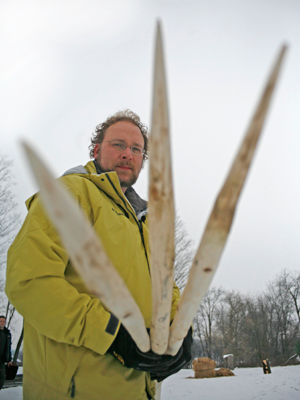Hunting for answers
 Were the Neanderthals savvy big-game hunters or more simple-minded scavengers? Last winter, a Kenyon duo took that question into their own hands—literally.
Were the Neanderthals savvy big-game hunters or more simple-minded scavengers? Last winter, a Kenyon duo took that question into their own hands—literally.
David Hohl '12 of Pinedale, Wyoming, and Associate Professor of Anthropology Bruce Hardy built and tested replicas of Neanderthal spears to see whether our much-maligned ancient cousins used long-distance throwing weapons. Or did they simply thrust their spears into their prey at close range?
The throwing-versus-thrusting debate has raged in academic circles since the discovery of some 300,000-year-old artifacts in Germany in 1999. "We're trying to see if these spears could have been thrown at a great enough distance to be effective hunting weapons," said Hohl, who pursued the project as an independent study. "If that proves to be the case, it demonstrates a pretty complex hunting strategy and gives us more latitude in thinking about the Neanderthal diet and survival skills."
He and Hardy, an expert on Neanderthals, built a ballista (a Roman crossbow, nearly ten feet long) that shot the spears at a target of ballistics gel (to test penetration) draped in cowhide acquired from a local butcher. The goal was to cover a flight of twenty to twenty-five meters, cited in the literature as a suitable distance for long-range hunting.
"If the spears are flung with enough force and velocity to puncture the cowhide, it is reasonable to assume the Neanderthals used them for hunting from a distance," Hardy said.
The duo spent much of the fall semester building the ballista and carving three replica spears from sycamore trees. On a frigid day at the Brown Family Environmental Center, while a small band of colleagues and friends huddled together, watching, they launched the test.
Result: The cowhide proved impenetrable. In another test, however, the spears easily poked through sheepskin. "We clearly showed that these spears were effective as long-range projectiles for thin-skinned animals, but not for thick-skinned," Hardy said.
Hohl logged the results of the spear launches, recording velocity, force, and launch angle. He is compiling data for possible submission to an academic journal. "Although the project addressed an important academic question, it has been a lot of fun," he said. "I got to play with some neat toys and shoot things in the air."

 Delicious
Delicious Facebook
Facebook StumbleUpon
StumbleUpon Digg
Digg reddit
reddit